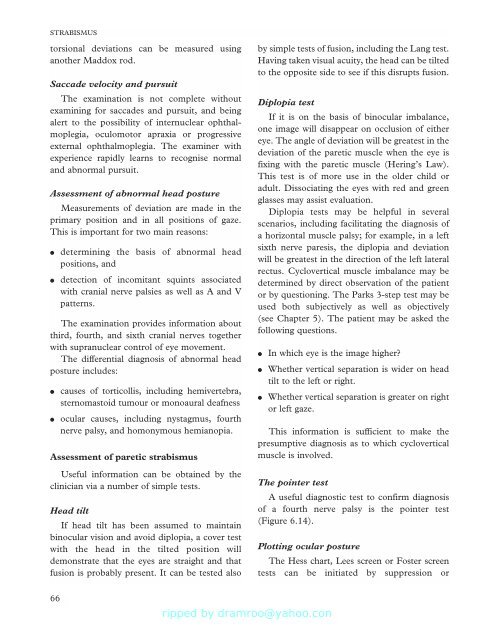Strabismus - Fundamentals of Clinical Ophthalmology.pdf
Strabismus - Fundamentals of Clinical Ophthalmology.pdf
Strabismus - Fundamentals of Clinical Ophthalmology.pdf
You also want an ePaper? Increase the reach of your titles
YUMPU automatically turns print PDFs into web optimized ePapers that Google loves.
STRABISMUS<br />
torsional deviations can be measured using<br />
another Maddox rod.<br />
Saccade velocity and pursuit<br />
The examination is not complete without<br />
examining for saccades and pursuit, and being<br />
alert to the possibility <strong>of</strong> internuclear ophthalmoplegia,<br />
oculomotor apraxia or progressive<br />
external ophthalmoplegia. The examiner with<br />
experience rapidly learns to recognise normal<br />
and abnormal pursuit.<br />
Assessment <strong>of</strong> abnormal head posture<br />
Measurements <strong>of</strong> deviation are made in the<br />
primary position and in all positions <strong>of</strong> gaze.<br />
This is important for two main reasons:<br />
●<br />
●<br />
determining the basis <strong>of</strong> abnormal head<br />
positions, and<br />
detection <strong>of</strong> incomitant squints associated<br />
with cranial nerve palsies as well as A and V<br />
patterns.<br />
The examination provides information about<br />
third, fourth, and sixth cranial nerves together<br />
with supranuclear control <strong>of</strong> eye movement.<br />
The differential diagnosis <strong>of</strong> abnormal head<br />
posture includes:<br />
●<br />
●<br />
causes <strong>of</strong> torticollis, including hemivertebra,<br />
sternomastoid tumour or monoaural deafness<br />
ocular causes, including nystagmus, fourth<br />
nerve palsy, and homonymous hemianopia.<br />
Assessment <strong>of</strong> paretic strabismus<br />
Useful information can be obtained by the<br />
clinician via a number <strong>of</strong> simple tests.<br />
Head tilt<br />
If head tilt has been assumed to maintain<br />
binocular vision and avoid diplopia, a cover test<br />
with the head in the tilted position will<br />
demonstrate that the eyes are straight and that<br />
fusion is probably present. It can be tested also<br />
by simple tests <strong>of</strong> fusion, including the Lang test.<br />
Having taken visual acuity, the head can be tilted<br />
to the opposite side to see if this disrupts fusion.<br />
Diplopia test<br />
If it is on the basis <strong>of</strong> binocular imbalance,<br />
one image will disappear on occlusion <strong>of</strong> either<br />
eye. The angle <strong>of</strong> deviation will be greatest in the<br />
deviation <strong>of</strong> the paretic muscle when the eye is<br />
fixing with the paretic muscle (Hering’s Law).<br />
This test is <strong>of</strong> more use in the older child or<br />
adult. Dissociating the eyes with red and green<br />
glasses may assist evaluation.<br />
Diplopia tests may be helpful in several<br />
scenarios, including facilitating the diagnosis <strong>of</strong><br />
a horizontal muscle palsy; for example, in a left<br />
sixth nerve paresis, the diplopia and deviation<br />
will be greatest in the direction <strong>of</strong> the left lateral<br />
rectus. Cyclovertical muscle imbalance may be<br />
determined by direct observation <strong>of</strong> the patient<br />
or by questioning. The Parks 3-step test may be<br />
used both subjectively as well as objectively<br />
(see Chapter 5). The patient may be asked the<br />
following questions.<br />
●<br />
●<br />
●<br />
In which eye is the image higher?<br />
Whether vertical separation is wider on head<br />
tilt to the left or right.<br />
Whether vertical separation is greater on right<br />
or left gaze.<br />
This information is sufficient to make the<br />
presumptive diagnosis as to which cyclovertical<br />
muscle is involved.<br />
The pointer test<br />
A useful diagnostic test to confirm diagnosis<br />
<strong>of</strong> a fourth nerve palsy is the pointer test<br />
(Figure 6.14).<br />
Plotting ocular posture<br />
The Hess chart, Lees screen or Foster screen<br />
tests can be initiated by suppression or<br />
66










![SISTEM SENSORY [Compatibility Mode].pdf](https://img.yumpu.com/20667975/1/190x245/sistem-sensory-compatibility-modepdf.jpg?quality=85)





